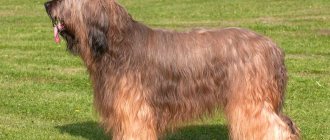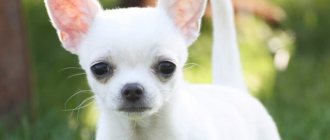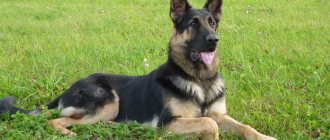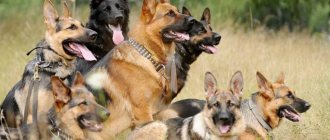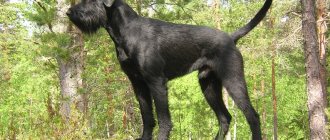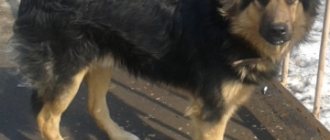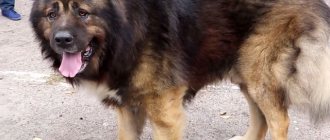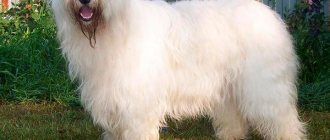There are dog breeds that combine large sizes with the appearance of decorative dogs. These species include the Briard, a dog breed native to France. Its original purpose was as a herding dog on peasant farms; the intelligent animal coped well with its duties. Today it is man's four-legged friend, a companion, distinguished by its unusual appearance and friendly character.
Description of the Briard breed
Popularity 245th place among 263 dog breeds
Lifespan::
11-13 years old
Breed group:
Shepherd's
Height:
males: 60-68 cm, females: 56-60 cm
Country of origin::
France
Average price::
15-45 thousand rubles
Weight: :
males: 30-40 kg, females: 25-35 kg
Latest articles Cat health
Rabies vaccination for cats: choice of vaccine, necessity, schedule 01/22/2022 16 0 0
Selection and adaptation
TOP 20 best cat breeds for families with children 01/22/2022 30 0 0
Breed standard
The French Briard combines power, harmony and a “hipster” appearance. This is a working dog, but its long coat requires no less care than the coat of decorative dogs.
| Parameter | Description |
| Height | 62-68 cm males, 56-64 cm females. |
| Weight | 30-39 kg. |
| Constitution | Strong, knocked down, but not rough. The muscles are developed, the skin elastically grips the body. |
| Frame | Elongated, slightly longer than tall. The back is straight, sloping down to a strong croup. The neck is cone-shaped, of medium length, and stands high. The chest is deep with rounded ribs. The lower back is convex, the stomach is moderately tucked. |
| Head | Rectangular and long - reaches 40% of the height. It is slightly less wide than it is long. The forehead is convex, the stop is pronounced. |
| Lips | Dry, tightly covering the teeth, black pigmentation. |
| Bite | Scissor-shaped. |
| Ears | They stand high and wide, covered with thick long hair. The ears hang down on the cartilage and rise when excited. They do not lie close to the cheekbones. In Europe, ear cropping is prohibited. In Russia they prefer French Briards with cropped ears. |
| Eyes | Large, round, stand wide. They are covered by overhanging eyebrows. Color – black or rich brown. Gray dogs are allowed eyes that match their color. |
| Nose | Black, square, nostrils well opened. |
| Limbs | Straight, parallel, bones and muscles are developed. Muscle relief is visible on the hind legs. |
| Paws | The pads are strong, collected in a ball, with black claws. Puppies are born with a single dewclaw on the front paws and a double dewclaw on the hind paws. On the front paws the rudimentary toe is docked, on the hind paws it is preserved. Fingers with two phalanges are a distinctive feature of French Shepherds, indicating their ancient origin. |
| Tail | J-shaped, standing low, tapering from tip to tip. Decorated with wavy, long hair. It reaches the hock joints or falls below them by 5 cm. When running, the dog carries its tail in line with the back. |
| Wool | Long, thick, with a slight wave, falling down the sides. Reminds me of a goat. On the body it reaches 15 cm, on the head it is somewhat shorter. The fur forms a parting on the top of the head, on the muzzle there is a beard and eyebrows that partially cover the eyes. |
| Color | Any one color except white. Dark shades are preferred - gray, brownish, black, fawn, red. |
The French Briard moves freely, smoothly, with a cat's step, as if gliding above the ground. This is one of the most beautiful dogs to work with.
Photos will not convey the beauty of the dog’s “gait,” but if you look at him in person, you will certainly fall in love.
Key facts
Briards are intelligent and friendly creatures who are well aware of their size and love to dominate smaller representatives. The owner of this strong dog must be an experienced dog breeder who can resist the pet’s manipulative habits.
Despite their impressive parameters, these giants are very graceful in movement. This is especially noticeable while running. Briards rearrange their paws very elegantly, moving briskly across open areas.
The Shepherd Dog is easy to train. Proper training makes a dog an excellent watchdog. Briards are very active even in old age. With proper care, pets live up to 13 years.
Raising a Briard
French Briards are smart and quick-witted. They quickly understand what is wanted from them and easily remember complex commands. But training dogs is not easy.
The fact is that the Briard dog breed is authoritarian, aware of its strength, and has its own opinion on everything, including education. Moreover, standard methods of establishing authority with a pet will not work. He doesn't like it when his will is suppressed.
Only affection, praise and treats are used in training. The French Briard will regard even a strict tone as an infringement on the sense of dignity, which is hypertrophied in the breed.
The owner needs to find an approach to a specific puppy. No two French Briards are alike. Which method will work with this particular tomboy is determined by character traits and habits.
If not raised correctly, the French Shepherd will become a vicious, uncontrollable animal.
The first commands are learned from 4 months. At 6-8 months they undergo a general training course (GTC) and a controlled city dog course (UCD). The rest is at the discretion of the owner. French Briards can be trained in any discipline.
Additionally, they develop the sharp mind of dogs. They are taught the daily little things that require thinking. Opening a drawer, bringing slippers or a ringing phone, putting a bowl in the sink - all this keeps French Briards from getting bored.
History of the origin of the Briard breed
The ancestors of the Briard were known back in the 12th century. At that time, large dogs were actively used by shepherds to herd flocks of sheep. The main advantage of four-legged guards was considered to be the ability to control the herd even without human commands.
The ancestor of the Briard could drive a flock of sheep out to pasture early in the morning, take it to the field, and drive the cattle back in the evening. Large dogs were bred in the French province of Brie. That's why they were called Briard Shepherds back then.
The first reliable description of the breed appeared in 1809. It was compiled by Abbe Ronier. He confirmed the excellent herding qualities of the dogs, and also pointed out their excellent guarding skills and increased performance. For several decades, Briard Sheepdogs were in great demand among peasants and farmers. And by the end of the 18th century they were identified as an independent breed.
The almost complete destruction of French Shepherds may have occurred during World War II. The fact is that shaggy dogs were an excellent draft force. They could pull out the wounded and deliver shells. The number of briards that died is unknown, but the remaining representatives of the breed were critically few.
In this regard, French breeders decided to take up the restoration of their population. In 1924, the Briard Club was founded for the first time. Thanks to enthusiasts, the number of French Shepherds began to recover. At the same time, the fluffy, robust dogs ceased to be perceived only as dogs for farmers and peasants - now they turned into companions.
By the middle of the 20th century, representatives of this breed ceased to be only French “property”. They began to spread to other European countries, and shepherd dogs also appeared in North America. However, briards did not gain much popularity overseas.
In the USSR, they learned about fluffy shepherd dogs only in the 1980s. Briards fell in love with their compatriots, so 10 years later Russian versions of French dogs appeared.
Diseases
Like representatives of any other breed, Briards are susceptible to certain diseases. More often than others, they have the following diseases:
- volvulus;
- hypothyroidism;
- epilepsy;
- hip dysplasia;
- lymphosarcoma;
- night blindness.
Often the first sign of an unwell dog is changes in the coat. The fur falls out and becomes dull. Timely examination and treatment will help prevent the development of complications. Often representatives of this breed suffer from parasites, which are not easy to detect due to their thick and long hair. Therefore, the dog owner should check it regularly.
Timely vaccinations will help maintain your pet's health, the first of which is done by the breeders themselves. The following vaccinations are given before the change of baby teeth. Then the dog is vaccinated every year. With good care, the life expectancy of these dogs is 12 years. It is important to follow all nutritional rules; if they are not followed, the dog may die from volvulus.
Briard appearance
A large shaggy dog will definitely attract the attention of not only other four-legged animals, but also all the people in the area. The graceful gait, coupled with the appearance of a simple-minded, good-natured man, makes the Briard simply irresistible.
General impression
The shaggy and always disheveled Briard is perceived as a charming, good-natured man with intelligent eyes. However, French breeders have been working on this hipster look for decades. Breeders did not want and still do not want to make changes to the exterior of the breed, trying to preserve the original appearance of the dogs.
Head
Due to the fact that the Briard has a large and slightly elongated body, its head looks disproportionate. She seems small. However, the skull has a neat and slightly elongated shape. The animal's forehead is rounded, with a strongly defined stop.
Nose, eyes and ears
The disheveled bangs and thick hair growing on the animal’s face make it impossible to look into the dog’s eyes. However, hair does not at all prevent the fluffy, robust guy from seeing the world around him clearly.
The eyes themselves are large and straight set. The iris is dark in color. For pets with gray fur, steel-colored eyes are acceptable.
But the black nose of the Briard is open. It has a wide, almost square shape and a flat bridge of the nose.
The ears are the only thing that has been “improved” by breeders. Since ancient times they have been docked. Therefore, according to the standards, the ears had to be in an upright position.
Now they have begun to refuse cupping. This led to some changes to the exterior. Now, when describing the Briard breed, they talk about dense ears, slightly adjacent to the skull. When uncropped, they reach half of the animal's head.
Teeth and bite
An adult specimen boasts a regular scissor bite and a snow-white grin of 42 strong teeth. Despite the fact that representatives of this breed are not hunters, their grip is particularly powerful.
By standard, dogs' gums are dark in color. But the tongue of French Shepherds, on the contrary, is bright pink and very long.
Neck
When you first look at the dog, your attention is drawn to its strong neck. It smoothly turns into powerful shoulders. The neck is covered with muscles and is shaped like a slightly truncated cone.
Torso
The dog's body has an elongated shape. It is completely covered with strong muscles. The stomach has a toned shape, but the chest protrudes somewhat. The back is straight and tense. The croup is round in shape.
Forelegs
The front legs of the French Shepherd are covered with strong muscles. The placement of the limbs is strictly vertical.
Hind limbs
The hind legs of the pet are muscular, with powerful hock joints. The limbs resemble cat paws thanks to elastic pads. The dog's claws are black. A distinctive feature of the breed is the paired dewclaws on the hind legs.
Tail
The furry pet's tail is low. At the end it bends into a hook.
Movements
The powerful movements of the animal are similar in grace to the gait of a cat. The dog walks slowly. This is surprising for an individual of such an impressive size, but the shepherd’s movements are devoid of clumsiness and rudeness.
Wool
By standard, a quadruped's fur should be rough to the touch. It resembles the structure of goat hair. On the face and belly the fur curls slightly. Elsewhere the hair is straight and long. They can grow up to 15 cm.
Color
Briard Sheepdogs come in a variety of colors. It's basically a solid color. The exceptions are white and chocolate colors, as well as shades of mahogany. Based on color, large pets are classified into the following types:
- red or reddish;
- gray;
- black;
- fawn;
- brown-silver;
- light brown.
Despite the fact that French Shepherds are not born spotted, they are characterized by these color features. For example, small tiger spots. According to the standard, two-color dogs have symmetrical coloring.
Size
Animals differ from each other according to their gender characteristics. Female Briards are smaller and more graceful than males. The height of females varies from 56 to 64 cm, males - about 68 cm.
Disqualifying faults
The exterior standards of the French Shepherd are quite strict. In a photo of a Briard, you may not see deviations from the breed, but an attentive breeder will immediately notice disqualifying defects. Here are the most significant signs:
- height 2 cm below or above standard;
- the nose is brown or pink;
- absence of 2-3 teeth;
- light-colored eyes or irises of different colors;
- fused or too low-lying ears;
- non-parallel hind limbs;
- the tail is vertical or lying on the back;
- too soft wool less than 7 cm long;
- white spots on the body or light hairs on the legs;
- the presence of dark spots on the fawn color.
Light-colored claws are considered no less important disqualifying faults. The absence of double dewclaws on the hind legs or their incomplete set is also a serious deviation from the norm.
Application
The Briard Shepherd Dog, like the Komondor and the South Russian Shepherd Dog , was bred as a herding breed, and for centuries it coped well with its purpose.
The Briard has not lost his absolute sense of smell, efficiency and desire for lightning-fast actions to this day.
However, nowadays dogs of this breed are kept as a beloved pet, a friend for the whole family, and a participant in dog shows and dog sports.
A distinctive feature of the Briard breed is a large head with a slightly rounded skull, strong and strong jaws, a straight back and a wide chest, a long tail and thick long hair.
Briard character
Despite its good-natured appearance, the Briard dog has a complex character. On the one hand, this is a companion, wholeheartedly devoted to his owner. But on the other hand, this is an animal that does not agree to play a secondary role. Representatives of this breed want to be the main thing in the life of their beloved owner.
In addition, furry pets have a jealous and touchy character. You should not provoke an animal with “ostentatious” love for a cat or other four-legged animal.
Dogs are inquisitive, friendly and very loyal. Their decorative appearance is deceptive - they need physical work and emotional release. Otherwise, the French Shepherd may become lethargic and apathetic.
If a Briard lives in an apartment, then he needs long, active walks. It's a great companion, but not for watching TV together. The pet will be happy to accompany the owner while jogging, while riding a bike, he will even be happy to swim nearby. But without physical activity, the animal can become embittered.
Representatives of this breed cannot fully exist without human communication, and separation is very difficult for them. They are so well socialized that they even like to be in crowded places. They are happy to meet guests and always happily participate in new games and entertainment.
Advantages and disadvantages of the breed
Briard is always a loyal friend and an interesting companion. But this breed is not suitable for people who have a sedentary lifestyle. An energetic and cheerful pet needs an equally active owner. Before getting this dog, you should carefully weigh all the pros and cons of this breed:
| Advantages | Flaws |
| Briards do not have seasonal shedding and corresponding problems with hair loss. | They cannot stand loneliness and boredom. The owner must take care of active leisure for the pet. |
| They are easy to train, know how to independently assess a situation and make decisions, and reach heights in any sport. | They require significant time and money in caring for the coat. |
| They get along great with children. | Difficult to keep in a cramped apartment. |
| They are never the first to show aggression. They can only protect the owner if necessary. | There are not many nurseries where Briards are bred. |
Education and training
Socialization
Briards are very intelligent and inquisitive dogs that are easy to socialize. But only if rough treatment and physical punishment are not used. The pet does not obey blindly and unconditionally: he thinks about what he is doing in advance.
If the dog has been trained, it will calmly remain alone, for example, at the door of a pharmacy or store. Most shepherd dogs have a balanced psyche, but there are representatives of the breed that are too temperamental - they need to take special courses in endurance training. But phlegmatic Briards are rare.
If you need a pet to participate in competitions, then a representative of this breed is ideal for this purpose. Possessing lightning-fast reactions, agility, flexibility and endurance, he is able to fulfill any wishes of the owner.
Briard as a service dog
Briard is a dog breed that requires training. Do not forget that these pets are classified as service pets. The owner needs to start raising the puppy from the first day it arrives in the house.
It is necessary to immediately explain to the dog what can be done and what cannot be done. It is important to praise and encourage your baby for everything he does right. Wrong actions, of course, need to be punished.
Do not yell at a puppy or an adult. It’s enough just to raise your voice or lightly slap a folded newspaper on the butt.
Purposeful training of Briard dogs should begin at 4 months. First you need to accustom your baby to a collar and leash. Then you need to develop the skill (calmly, without rudeness) to walk nearby. And only after this move on to the basics of obedience. This includes four commands: “Sit!”, “Lie down!”, “Stand!”, “Come to me!”.
You can start special training courses for furry giants from the age of six months. By 6 months, the pet perfectly perceives the trainer’s commands and carries them out with pleasure. The following courses are perfect for French Shepherds:
- General training course (GTC);
- Controlled city dog (UGS);
- International obedience system (obedience).
If something doesn’t work out, it’s better to contact a professional trainer. Once your four-legged friend has mastered the basic commands, you should move on to more complex training, if necessary.
Looking for a Briard? Find your pet from 1 offer As a gift
Training
Briard is a smart dog, cheerful and energetic. To train him, the preferred methods are praise and encouragement. Teams and games should be varied. Monotonous training may bore your pet, and he may refuse to follow commands. First, complete obedience must be achieved. Then you can begin full training.
Serious loads on the spine and joints are possible only after strengthening the bones - after reaching the age of 1.5 years. Briards have good learning abilities and often become champions in various types of challenges. Before you begin training your Briard, it is important to consult with a specialist breeder about how to do it correctly. It is better to prepare thoroughly than to treat your pet’s deranged psyche later. These intelligent creatures cannot stand rudeness and physical punishment.
Briard Health and Diseases
Possible diseases
Dogs of this breed are characterized by the same diseases as most four-legged giants. Many of them are associated with poor heredity or improper care. For example, a Briard may be allergic to food, improperly selected vitamins and feed.
The most common diseases:
- epilepsy;
- night blindness;
- hip dysplasia;
- cataract;
- viral diseases;
- von Willebrand-Diana disease;
- intestinal volvulus;
- cancer;
- autoimmune thyroiditis.
To maintain the health of your four-legged friend, you need to regularly visit the veterinary clinic. This will help reduce the risk of disease. In addition, it is important to get preventive vaccinations once a year.
Reproductive health and breeding
The best time for mating a female and a male is considered to be 2-2.5 years old. By this period, the animal’s reproductive organs are fully formed and ready to reproduce healthy offspring.
An important nuance is that after the bitch starts estrus, you need to wait 4 days - and only then breed the pets.
A pregnant female needs a diet enriched with beneficial microelements and vitamins. Large dogs bear their offspring for about 67 days.
Socialization
The Briard breed is not compatible with other pets. They are too jealous owners. Dogs do not want there to be room in their owner's heart for another animal.
French Shepherds are indifferent to other people's pets as long as the owner does not pay attention to them. All you have to do is pet a St. Bernard, and the Briard will explode with indignation.
French Briards get along with children, but only if they know how to handle the dog. No pulling fur or playing pranks - dogs will not forgive such an attitude.
Briards are cool and wary of strangers. And they always expect a catch. Passers-by should not pet dogs - they will not appreciate familiarity.
It is important that French Briards know how to react correctly to strangers and animals. They are socialized from 3 months. If this is not done, shepherds will grow up to be fearful, withdrawn or aggressive.
Features of feeding and diet
When welcoming a large dog into your home, it is worth considering that such four-legged friends eat a lot. This aspect requires special attention. Like most breeds, Briards can be fed both natural food and prepared diets. But mixed food is not suitable for them, as this can undermine the pet’s health.
Fluffy giants need a balanced diet, the basis of which is meat. Additional ingredients are:
- vegetables (carrots, pumpkin, zucchini);
- greenery;
- cereals (millet, buckwheat, oatmeal, oat flakes).
It is not recommended to give your pet potatoes; it is also advisable to remove rice, bread and other baked goods from the menu.
The serving size depends on the dog's body weight and activity. Briards have excellent digestion, so they almost never have an upset stomach.
However, it should be remembered that in the hot months, four-legged animals move less, so it is advisable to reduce the amount of protein food they consume. At this time, it is important to enrich the diet with vitamin E and nutritional yeast. In addition, you can give them a small amount of vegetable oil - for example, 1 tablespoon of peanut or sunflower oil.
If the owner decides to feed the dog with ready-made industrial food, then it must be a premium quality product. It is important to choose ready-made food for large individuals with long hair.
If a pet does not receive enough trace elements and vitamins, this immediately affects the condition of the coat. When the diet changes for the better, but the pet’s appearance continues to deteriorate, you should consult a veterinarian.
How to choose a puppy
Healthy Briard puppies are lightly nourished and have a good appetite, their coat is shiny, their ears and eyes are clean, and their nose is moist.
A good puppy does not show aggression, is not afraid of people and does not withdraw into himself.
A distinctive feature of the breed is a large head with a slightly rounded skull, strong and strong jaws, a straight back and a wide chest, a long tail and thick long hair.
Important! In Russia, this breed of French Shepherd is not widespread, and therefore it is better to choose a puppy in specialized nurseries, in this case you will be sure of the purebred of the breed.
Briards are loyal and selfless, ready to protect their owner and his family. These good-natured dogs are very brave animals.
Care and maintenance
Grooming
Briard wool is their pride, and, naturally, to make it look beautiful and well-groomed, some effort is required from the owners. But here, too, a certain plus can be noted - representatives of this breed do not have seasonal shedding. This means that there will be no wool in the house.
However, dogs require regular grooming. They should be brushed daily and this process can take up to 2 hours. Only in this case the wool will not become tangled, it will become smooth and shiny, and will remain clean for a long time.
If the dog does not participate in exhibitions, the coat may be somewhat shortened. This will make it easier to care for your pet's appearance. You should visit a professional groomer at least once every 2-2.5 months.
The following procedures must be carried out at least once a week:
- inspecting the fur for fleas, ticks and other parasites;
- washing or rubbing the eyes;
- cleaning plaque from teeth and gums;
- removing dirt from pads.
Bathing is required regularly - once every 4-5 weeks or more often if the dog becomes dirty. An interesting feature of briards is that when wet, the hair emits the smell of sheep's wool.
The fur on the pads and ears should be trimmed regularly.
Walk
A very important condition for a strong fluffy dog is mandatory long walks in the fresh air. They must be carried out 2 times a day, and they should last 1.5-2 hours. It is important to keep the giant busy with training, outdoor games, and jogging.
It is best to walk with a Briard in crowded places. Thanks to this, the dogs will get used to people and other animals. First, you need to hold the leash tightly, wrapping it around your hand. Over time, the lace can be loosened.
Breed traits
Breed traits (on a 5-point scale)
| Briard | |||
| Activity | in the house | 2.3 | |
| on the street | 4 | ||
| Obedience | training | 3.7 | |
| strangers | 4.7 | ||
| Domination | in family | 3.8 | |
| over dogs | 4.2 | ||
| Defending your territory | from people | 4 | |
| from dogs | 3.8 | ||
| Sociability | in family | 5 | |
| with strangers | 3 | ||
| with dogs | 2.7 | ||
| Concentration | in family | 1 | |
| in front of strangers | 4.3 | ||
| with dogs | 3.2 | ||
| Aggressiveness | in family | 1.5 | |
| to strangers | 2.2 | ||
| to the dogs | 2.5 | ||
| to cats | 1.8 | ||
| Family behavior | calmness | 4 | |
| demand for affection | 4.2 | ||
| excitability | 4.5 | ||
| playfulness | 4.3 | ||
| excessive barking | 2.7 | ||
| behavioral breakdowns | 1.3 | ||
| Tolerance for children | up to 4 years | 3.6 | |
| over 4 years old | 3.6 | ||
| Institutional use | watchman | 5 | |
| bodyguard | 4 | ||
This breed is often compared to the following dog breeds: Bobtail (Old English Sheepdog), Bouvier des Flanders, Tibetan Spaniel, German Shepherd, Yorkshire Terrier.
The photo shows what a briar looks like:
Tips for choosing a puppy
Before you buy a baby, you need to familiarize yourself with the standards of this breed. For example, do not forget that a Briard puppy must have two dewclaws on its hind legs.
You need to choose your future four-legged friend carefully. Please note that the largest and fattest baby in the litter may not fit into the size standards.
When choosing, pay attention to:
- nursery status;
- appearance of the baby's parents;
- no signs of umbilical hernia;
- no traces of diarrhea under the tail.
Many people are surprised that a Briard puppy is very similar to an ordinary mongrel. This is fine. With age, the shaggy little ball changes and turns into a real fluffy giant.
Psychology
A devoted friend and faithful protector, a cheerful and good-natured companion dog, not only is the appearance of the Briard unique, but its character has many advantages:
- High intelligence. Briards, like Groenendaels and Swiss Shepherds , are unusually smart dogs, their intelligence allows them to quickly assess the situation and react to it, make their own decisions and act immediately. They are trainable, participate in various sports and show excellent results.
- Sociability. Dogs of this breed love company and love to be the center of attention, and have a cheerful disposition. But with undeserved rudeness, he can withdraw into his splendid isolation. However, it is not difficult to restore good relations with a Briard: just say a kind word to him and scratch him behind the ear.
- Dedication. Briards are loyal and selfless, ready to protect their owner and his family. These good-natured dogs are very brave animals.
Briards are very sensitive, the approach to them should be affectionate and soft. They have a sense of tact and are not annoying
- Lack of aggression. French Shepherds do not show unreasonable aggression; they get along well in the family and get along well with other animals, if any.
- Endurance and performance. These are hardy dogs, not afraid of work and ready to serve people.
- Sensitivity. Briards are very sensitive, the approach to them should be affectionate and soft. They have a sense of tact and are not annoying.
- Love for children. For children, the Briard will become the best friend, showing maximum care and attention, allowing more than it should.
You can learn about other non-aggressive dog breeds here:
Important! Raising dogs of this breed is not difficult, as they are inclined to dialogue with humans. However, Briards require early socialization and training.
The Briard Sheepdog was bred as a herding breed and has served its purpose well for centuries. However, nowadays dogs of this breed are kept as a beloved pet, a friend for the whole family, and a participant in exhibitions and dog sports.
Briard Health
The lifespan of French Briards is 10-12 years. Some dogs celebrate their 14th and 15th birthdays.
Diseases
Briard dogs are prone to:
- dysplasia;
- epilepsy;
- volvulus of the intestines and stomach;
- hypothyroidism;
- cancer;
- retinal atrophy;
- hemeralopia;
- allergies are rare.
Most pathologies are hereditary. If a French Briard puppy is adopted from healthy, defect-free parents, it will live a long life without frequent trips to the vet.
Vaccinations
French Briards are vaccinated against:
- plague;
- rabies;
- parainfluenza;
- enteritis;
- herpes;
- coronavirus.
The vaccination schedule is compiled by a veterinarian. Puppies are vaccinated 4 times up to 12 months; adult Briards are given a comprehensive vaccine annually.
They take care of the hair and skin of French Briards. Due to the long thick hair, parasites constantly inhabit the fur coat, which are difficult to detect. Antiparasitic treatment and prevention of helminths every 3 months are indicated.
Mating
- The first estrus in these animals occurs at 8-10 months of life. But this early the female is not yet ready for mating.
- A dog of this breed will be ready to bear offspring only in the second year of life, or rather, during the third estrus.
- The female is ready for mating on the 10-12th day of estrus.
- Males are ready by 1.5 years . However, this process occurs individually in each animal. Therefore, the timing may vary. An experienced female is selected for an inexperienced male and vice versa.
As a rule, a female is brought to the male and given time to become friends. At the same time, it is necessary to ensure a calm environment, otherwise the pets will get scared and twitch. To breed healthy puppies, a purebred partner is selected.
Health
Brie Sheepdogs suffer from several hereditary pathologies:
- Retinal atrophy. Vision gradually decreases, then blindness occurs. Can't be cured.
- Problems with joints (dysplasia). Expressed by lameness and painful movements. Only timely surgical intervention will alleviate the situation.
- Von Willebrand's disease. A bleeding disorder manifests itself as sudden, abnormal bleeding (due to injury or routine surgery) from the nose or when urinating. Risks the death of the animal. Immediate consultation with a doctor and a transfusion of plasma or whole blood is indicated.
- Volvulus. Blockage of the intestinal passage, requiring immediate surgery.
These shepherds do not live too long, only about 10–11 years.
Dogs must be vaccinated annually, given anthelmintic drugs every 7–8 months, and also treated against skin parasites using drops on the withers, sprays, collars, etc.
History of the breed
Briards (also known as French Shepherds) appeared in the 18th century, but the first written records of these dogs date back to the 12th century. Opinions about the origin of the breed differ. According to some sources, the animal lived independently in the wild.
According to another opinion, Briard is the result of crossing Berger de Bosses and Barbet.
Official breed standards were registered in 1885. After this, dogs with toy appearance became frequent participants in international exhibitions.
Today, representatives of this breed are known as good companions and talented search dogs.
In addition, Briards are considered one of the best guide dogs for people who are blind.
Appearance
Briard is a fairly large animal with a strong build. The height of an adult dog is about 65-68 cm, weight - 40 kg.
The breed's calling card is its long, silky wool, which smells like sheep's when wet.
The colors of these dogs can be very diverse. Puppies are born with dark fur, which becomes noticeably lighter with age. Most often, representatives of this breed are found in black, red, gray and combined colors.
White color is considered a deviation from established standards.
Briards have a wide muzzle, with a slightly flattened nose and developed jaws. A beard, bangs, mustache and eyebrows give the animal a funny, original look.
Despite its large volumes, the animal is famous for its lightness, smoothness and gracefulness of movements.
Character
The main character trait of the Briard is good nature. Despite their impressive size, representatives of this breed are not prone to attacks or displays of aggression.
The exception is situations that pose a potential danger to the dog’s owners.
Briards are socially adapted animals. The dog is calm and friendly towards strangers and behaves decently in crowded places. Representatives of this breed tolerate various trips and changes of residence well.
But the animal reacts negatively to loneliness. Separation from the owner can even cause the pet to become ill.
Representatives of this breed are characterized by mobility and activity. The dog needs long walks and regular exercise. Otherwise, the animal will become lethargic and passive.
Finds a common language with children and other pets, including cats . The dog shows hunting instincts only towards rodents .
Briard is famous for his sharp mind. Therefore, the animal needs not only physical, but also intellectual stress, various activities, and training.
At competitions, representatives of this breed always strive to show their best side.


